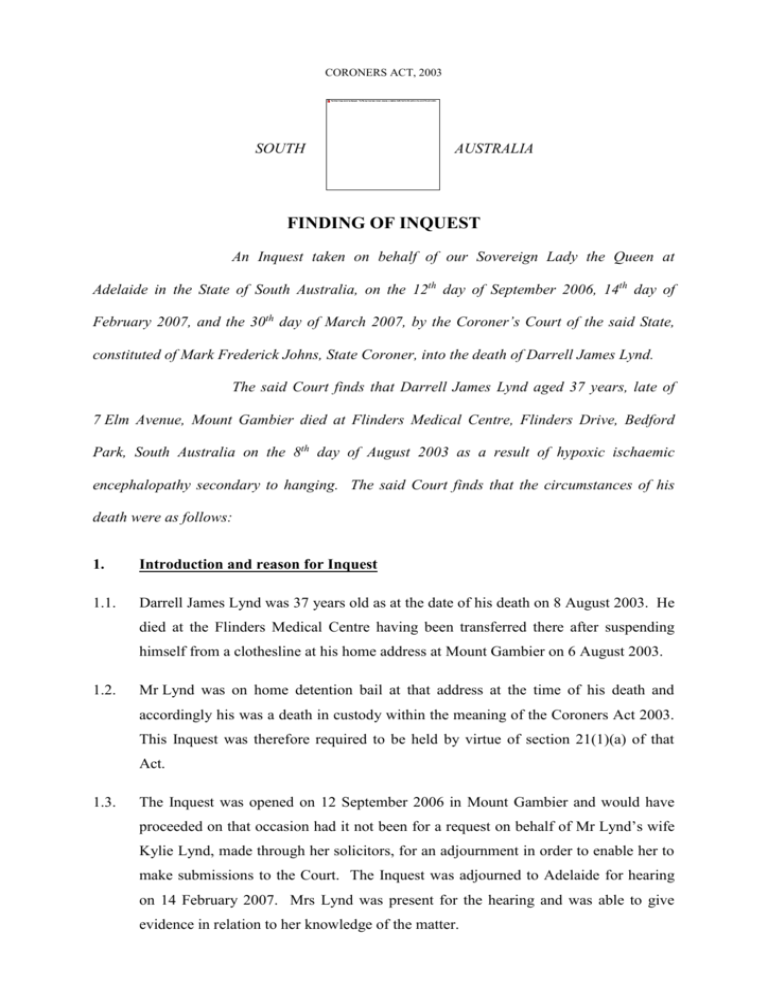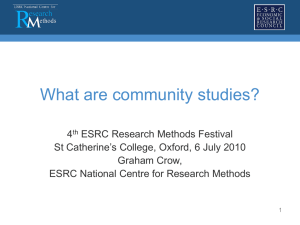LYND Darrell James - Courts Administration Authority
advertisement

CORONERS ACT, 2003 SOUTH AUSTRALIA FINDING OF INQUEST An Inquest taken on behalf of our Sovereign Lady the Queen at Adelaide in the State of South Australia, on the 12th day of September 2006, 14th day of February 2007, and the 30th day of March 2007, by the Coroner’s Court of the said State, constituted of Mark Frederick Johns, State Coroner, into the death of Darrell James Lynd. The said Court finds that Darrell James Lynd aged 37 years, late of 7 Elm Avenue, Mount Gambier died at Flinders Medical Centre, Flinders Drive, Bedford Park, South Australia on the 8th day of August 2003 as a result of hypoxic ischaemic encephalopathy secondary to hanging. The said Court finds that the circumstances of his death were as follows: 1. Introduction and reason for Inquest 1.1. Darrell James Lynd was 37 years old as at the date of his death on 8 August 2003. He died at the Flinders Medical Centre having been transferred there after suspending himself from a clothesline at his home address at Mount Gambier on 6 August 2003. 1.2. Mr Lynd was on home detention bail at that address at the time of his death and accordingly his was a death in custody within the meaning of the Coroners Act 2003. This Inquest was therefore required to be held by virtue of section 21(1)(a) of that Act. 1.3. The Inquest was opened on 12 September 2006 in Mount Gambier and would have proceeded on that occasion had it not been for a request on behalf of Mr Lynd’s wife Kylie Lynd, made through her solicitors, for an adjournment in order to enable her to make submissions to the Court. The Inquest was adjourned to Adelaide for hearing on 14 February 2007. Mrs Lynd was present for the hearing and was able to give evidence in relation to her knowledge of the matter. 2 2. Cause of death Professor Byard carried out a post mortem examination of the deceased and provided a written report which was admitted as Exhibit C3a in these proceedings. Professor Byard gave the cause of death as hypoxic ischaemia encephalopathy secondary to hanging and I so find. 3. Background 3.1. Exhibit C1a in these proceedings is a statement made by Mrs Lynd to a member of police stationed at Mount Gambier Police Station on 13 June 2003. The statement alleges that on 17 May 2003 Mrs Lynd was at home at 7 Elm Avenue, Mount Gambier with her three children aged seventeen weeks, four years and six years. Her husband was staying with her, although they had recently separated. At approximately 5:00pm that day she had an argument with her husband during which Mr Lynd allegedly punched Mrs Lynd, hitting her above her right eyebrow and knocking her to the ground. She alleged that Mr Lynd kicked her causing her to suffer a blackout. According to the statement this assault was witnessed by the children. This complaint led to Mr Lynd’s arrest on 13 June 2003. He was arrested at the home address of 7 Elm Avenue, Mount Gambier. At the time of his arrest he assaulted a number of police officers. Police bail was refused and Mr Lynd was remanded in police custody pending a Court appearance. 3.2. The following day, 14 June 2003, Mr Lynd complained of central chest pain and was admitted to the Mount Gambier Hospital. Investigations at the hospital showed that the pain was unlikely to be of cardiac origin and the clinicians thought that it was likely to be related to anxiety. During the admission, Mr Lynd reportedly confided to nursing staff that he felt very stressed and had had thoughts of suicide. The Mount Gambier Hospital records were admitted as Exhibit C20 in these proceedings and according to the discharge summary from this admission, Mr Lynd was diagnosed as having anxiety related chest pain with depression and suicidal ideation. 3.3. On 17 June 2003 Dr McQuillan of the Mount Gambier Hospital discussed Mr Lynd’s case with a psychiatry registrar at the Royal Adelaide Hospital and it was determined that in view of Mr Lynd’s suicidal ideas and anxious state he should be detained pursuant to the Mental Health Act. He was so detained and was transferred to 3 Adelaide where he was briefly admitted to a ward at the Glenside Campus on 17 June 2003. He was transferred to James Nash House on 18 June 2003. 3.4. The James Nash House medical records for Mr Lynd were admitted as Exhibit C19 in these proceedings. They describe a suicide attempt on the previous Friday following a fight with Mr Lynd’s wife after which Mr Lynd’s wife had contacted the police to seek assistance. It appears that Mr Lynd informed the author of the note that when the police attended he thought that they were bikers coming to get him. 3.5. At this point it is convenient to interpolate that there was evidence from Mrs Lynd that she and Mr Lynd had decided to live in Mount Gambier because it was the only place in Australia where they had friends and support and where there was not a “chapter” of the Rebels Motor Cycle Club1. Mrs Lynd also stated that Mr Lynd had been a member of the Rebels Motor Cycle Club in Tasmania for many years and had led a chapter of that club in Launceston. However, following a heart bypass operation in November 2002 he had asked the Rebels if he could withdraw from the club to have time off to recover from his heart condition. This was apparently refused but Mr Lynd left the club in any event2. I infer that Mr Lynd had moved to Mount Gambier in an attempt to avoid any further confrontation with members of the Rebels Motor Cycle Club and may have been in fear of some form of retribution following his withdrawal from the club. Certainly the James Nash House notes appear to support the proposition that he was afraid that bikers were coming to get him and that he feared them. 3.6. At the time of his admission to James Nash House he was assessed by psychiatrist Dr Nambiar. Dr Nambiar determined that Mr Lynd was suffering from chronic dysthymia, anxiety symptoms and an antisocial personality disorder. Mr Lynd was content to stay at James Nash House and accordingly his detention order was revoked. Mr Lynd remained at James Nash House as a voluntary patient. He admitted to having regular suicidal thoughts and reported previous suicide attempts. He was diagnosed as suffering from depression and was commenced on antidepressant medication. On 1 July 2003 he was discharged from James Nash House and returned to the custodial system. He was admitted to the Adelaide Remand Centre on that day. A psychiatry registrar at James Nash House, Dr Chow, issued a potential self-harm notification form on that day. The purpose of the form was to warn prison health staff 1 2 Transcript, page 15 Transcript, page 15 4 of the potential for self-harm by Mr Lynd. The notification also advised that he had the potential for aggression towards others, poor frustration tolerance and poor impulse control. 3.7. Mr Lynd was transferred from the Adelaide Remand Centre to the Mount Gambier Prison on 23 July 2003. A home detention report had been prepared on 9 July 2003 while Mr Lynd was at the Adelaide Remand Centre in preparation for a Court attendance on 22 July 2003. The report states: ‘The defendant could access mental health services through ACIS (Acute Crisis Intervention Service) if required but no long term treatment plan has been developed for future management. The defendant acknowledges that he experienced periods of feeling suicidal but now felt that the antidepressant medication assisted and that he was not at risk of self-harm.’ 3.8. Mr Lynd was released on home detention bail on 25 July 2003. According to Exhibit C1c, a statement made by Mrs Lynd on 10 August 2003, Mr Lynd’s mental state following his release on home detention was much better than when he was first admitted to James Nash House, although Mrs Lynd conceded that it had not been “one hundred percent”. 3.9. According to Exhibit C1c, Mrs Lynd and Mr Lynd were at home together watching television on the evening of 6 August 2003. They had just commenced to watch a television program commencing at 7:30pm, and approximately ten minutes into the program, Mrs Lynd left the room to go to the toilet. While in there she heard a banging noise in the backyard which sounded like the clothesline. She thought that it was the wind. When she returned to the dining room she saw that the back door was open, although the screen door was closed. She opened the screen door to put the dog outside and then saw Mr Lynd hanging from the clothesline in the back yard. She immediately went to the telephone and rang the Mount Gambier Hospital and was told to ring 000. She did this and then went outside. She attempted to support Mr Lynd’s weight and was telling him to stand up but he did not respond. A man and a woman who apparently lived across the road came over in response to Mrs Lynd’s calls for assistance. The woman cut the rope while the man helped to support Mr Lynd’s weight. An ambulance crew arrived and attempted to resuscitate Mr Lynd. He was conveyed to the Mount Gambier Hospital from where he was retrieved to the Flinders Medical Centre. As I have already stated he died at the Flinders Medical Centre on 8 August 2003. 5 3.10. I have mentioned that Mrs Lynd attended at the Inquest and gave oral evidence. She explained that when she attended the Mount Gambier Police Station on 13 June 2003 and gave a statement concerning the assault which had taken place several weeks previously, she was motivated by the fact that Mr Lynd had, on that day, attempted to hang himself from a manhole in the house at Elm Avenue. She cut him down and sorted him out and gave him his medication. She then went to a telephone box where she called the police station and asked for advice about what to do. She was invited to attend at the police station and was told that it may be possible for police to take some action under the Mental Health Act. According to Mrs Lynd, this was why she went to the police station – not primarily for the purpose of making a complaint against her husband for the events of the earlier assault. She explained in her evidence that the officers had been aware of the likelihood of an assault having taken place in May because they had attended at the address on that day although had not been admitted to the house. The police officer believed that something had happened in the nature of domestic violence, and suggested that they take a statement from her in case Mr Lynd did not cooperate by permitting the police to discuss his mental health issues. Mrs Lynd described this as a “backup plan” and that her motivation was to seek assistance for Mr Lynd given his suicidal behaviour on that day3. 3.11. I accept Mrs Lynd’s explanation of her motivation in attending the police station on that day. However, this does not alter the fact that Mr Lynd’s arrest was perfectly appropriate bearing in mind his violent behaviour towards police when they attended at the house. 4. Expert overview 4.1. Dr Chris Branson, Forensic Psychiatrist, was asked to review all available material with a view to commenting on the appropriateness of the treatment provided to Mr Lynd before his death. Dr Branson provided a report dated 5 July 2006. The report was admitted as Exhibit C8a in these proceedings. In the report, Dr Branson stated that he considered that the level of care provided to Mr Lynd at James Nash House was appropriate and non-controversial. He considered that the diagnosis made at James Nash House, of adjustment disorder with mixed disturbance of mood and conduct, was appropriate. He considered the treatment with antidepressant medication was appropriate and reasonable. Dr Branson further commented that the 3 Transcript, page 17 6 discharge to the Adelaide Remand Centre was handled appropriately and there would have been little more to be gained by keeping Mr Lynd at James Nash House. He considered that appropriate notifications were made about Mr Lynd’s potential for self-harm. He further stated that Mr Lynd’s potential for self-harm at that time was not acute or immediate, but it was certainly clear that he would always be at risk of suicidal ideation while under stress, and no amount of treatment with medication would change that. 4.2. Dr Branson stated that it might have been made a condition of Mr Lynd’s bail that he received psychiatric assessment and treatment. However, he expressed the view that it is unlikely that Mr Lynd would have been capable of making use of such support given his personality structure which rendered him unlikely to be able to trust others to the extent that he would open up about his feelings in a therapeutic relationship. He stated: ‘The situation was left at the point that the Mental Health Services were available to Mr. Lynd if he wished to access them which inevitably he did not.’4 4.3. Dr Branson commented that there seemed a certain sad inevitability about Mr Lynd’s demise. He regarded Mr Lynd as a man who was ill equipped to cope with emotional stressors including especially his own physical incapacity resulting from his heart disease. He noted that Mr Lynd no longer had the rigid support of the motor cycle culture which he had previously been accustomed to. Dr Branson stated that as is the case with many very antisocial men, Mr Lynd would deal with stress by impulsive, aggressive actions rather than by considered introspection. Dr Branson considered that the high level of medical intervention in Mr Lynd’s life in the last few months would have been very difficult for him to accept, given his previous self image as an independent person who was physically strong and capable. Dr Branson considered that little else could have been done for Mr Lynd that would have affected the eventual outcome. 4.4. According to Exhibit C9a, a report to the Minister for Correctional Services from the Chief Executive of the Department for Correctional Services, Mr Lynd had reported to the Mount Gambier Community Corrections Centre on three occasions, on 28 and 30 July 2003 and 6 August 2003. Furthermore, a routine home detention telephone call was made to his home at 6:00pm on 6 August 2003 which reported nothing untoward. 4 Exhibit C8a, page 7 The report states that the on-call case manager became aware that 7 something was amiss when the transmitter “out of range” alert from Mr Lynd’s home detention electronic tracking device was reported at 8:34pm on 6 August 2003. The Mount Gambier Police were contacted and the police advised that Mr Lynd had hanged himself from his clothesline. 5. Conclusion 5.1. I agree with Dr Branson’s opinion that there was a certain sad inevitability about Mr Lynd’s demise. I also accept that Mrs Lynd had not approached the police on 13 June 2003 with the intention of procuring his arrest on criminal charges, but was rather motivated by a desire to prevent him from harming himself further following the suicide attempt which he made on that day. As it happens, Mrs Lynd’s intervention did result in Mr Lynd being provided with appropriate psychiatric treatment at James Nash House. 5.2. Unfortunately, as Dr Branson noted, Mr Lynd was not the sort of person who likely to be amenable to ongoing therapeutic relationships by virtue of his antisocial personality disorder. I find that Mr Lynd attempted to take his own life by hanging himself on the evening of 6 August 2003, finally suffering an hypoxic brain injury associated with the prolonged oxygen deprivation resulting from the episode of hanging. Key Words: Death in custody; Home release/detention; Ischaemic heart disease. In witness whereof the said Coroner has hereunto set and subscribed his hand and Seal the 30th day of March, 2007. State Coroner Inquest Number 29/2006 (2168/03)






